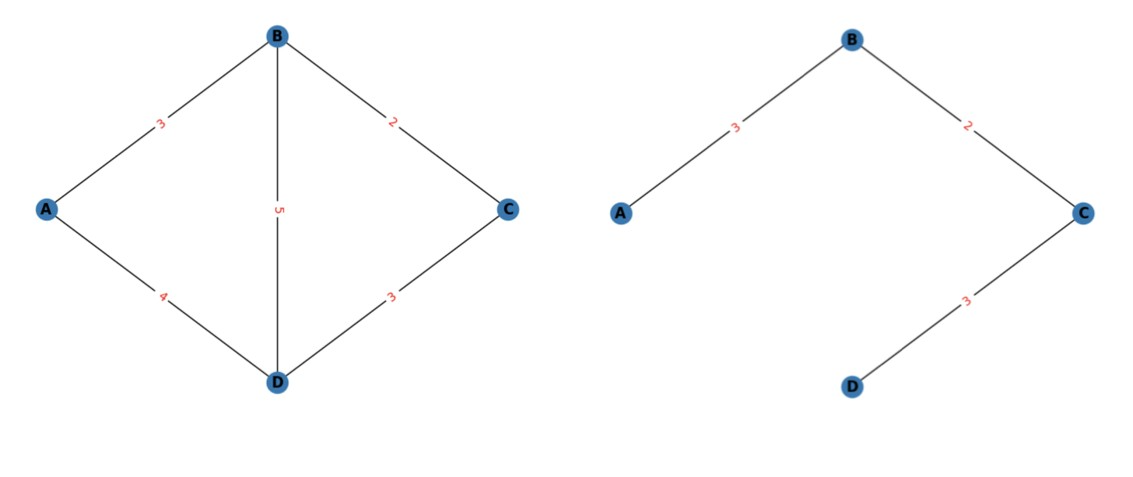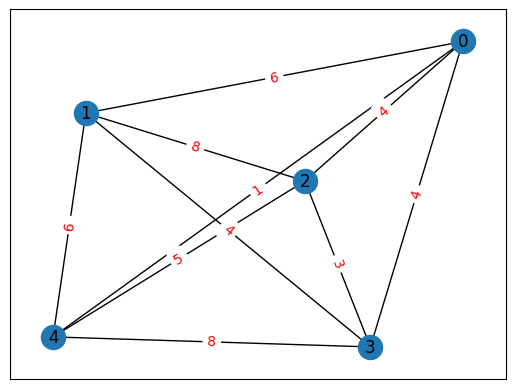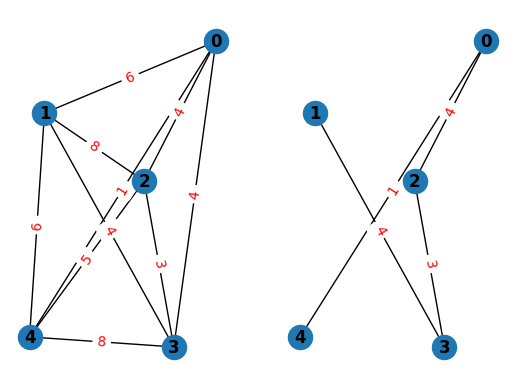最大次数制約を持つ最小スパニングツリー問題#
ここではJijZeptSolverとJijModelingを用いて、最大次数制約を持つ最小スパニングツリー問題を解く方法を説明します。 この問題は、Lucas, 2014, “Ising formulations of many NP problems” 8.1. Minimal Spanning Tree with a Maximal Degree Constraint で触れられています。
最大次数制約を持つ最小スパニングツリー問題とは#
最小スパニングツリー問題は、次のように定義されます。 各辺\((uv) \in E\)がそれぞれコスト\(c_{uv}\)を持つような、無向グラフ\(G=(V, E)\)が与えられたとします。 全ての頂点を含むようなツリーである、スパニングツリー \(T \subseteq G\)を構築することを考えます。 もし\(T\)が存在するとき、そのコスト
を最小化することを考えるのが、この最小スパニングツリー問題です。 そしてここに、\(T\)に含まれる頂点の次数が\(\Delta\)以下でなければならないという、最大次数制約を加えます。
例題#
簡単のため、ここでは次のような単純なグラフを見てみましょう。
左グラフにおいて、最大次数が3で制限されるような、最小スパニングツリーを求めてみましょう。
この問題に対する答えは、右のグラフのようになります。
このツリーの重みの総和は8で最小です。
そして最大次数制約も満たされていることがわかります。

数理モデル#
辺\(e=(uv)\)が最小スパニングツリー\(T\)に含まれるとき1、そうでないとき0となるようなバイナリ変数\(x_{uv}\)を導入します。
制約 1: 各頂点は最大で\(\Delta\)まで辺を持つことができる
グラフにおけるどの頂点の次数も、\(\Delta\)を超えることはできません。 ツリーでは少なくとも1つの辺を持たなければならないため、各頂点の次数に下界を考える必要があります。
\(x_{uv}, x_{vu}\)についての総和であることに注意が必要です。
制約 2: ツリーは全ての頂点を含めなければならない
選択された辺は、全ての頂点を含めるような木を形成しなければなりません。 もし\(T\)の辺の合計が\(|V|-1\)より小さいならば、\(T\)は全ての辺を含めることができません。 そして\(T\)の辺の合計が\(|V|-1\)より大きければ、\(T\)はツリーではなくなります (この場合、グラフにループが存在することになります。)
制約 3: 切断制約
この制約により、解のグラフがバラバラでなく接続されており、非巡回グラフとなることを保証します。
ここで\(S\)はグラフ\(G\)の部分グラフ、そして\(E(S)\)は\(S\)内に含まれる辺の集合です。
目的関数
\(T\)の重みの総和を最小化する目的関数を設定します。
JijModelingによるモデル化#
次に、JijModelingを用いて数理モデルを実装しましょう。 最初に、上述の数理モデルに必要な変数を定義します。
import jijmodeling as jm
#define variables
V = jm.Placeholder('V') # number of vertices
E = jm.Placeholder('E', ndim=2) # set of edges
num_E = E.shape[0]
C = jm.Placeholder('C', ndim=2) # cost between each vertex
D = jm.Placeholder('D') # number of degrees
S = jm.Placeholder('S', ndim=3) # list of set of subgraph edges
num_S = S.shape[0]
S_nodes = jm.Placeholder('S_nodes', ndim=1) # list of number of subgraphs vertices
x = jm.BinaryVar('x', shape=(num_E,))
v = jm.Element('v', V) # subscripts for verteces
e = jm.Element('e', num_E) # subscripts for edges
i_s = jm.Element('i_s', num_S)
e_s = jm.Element('e_s', S[i_s].shape[0]) # subscripts of edges in S
制約と目的関数を実装しましょう。
problem = jm.Problem("minimum spanning tree with a maximum degree constraint")
problem += jm.Constraint('const1-1', jm.sum((e, (E[e][0]==v)|(E[e][1]==v)), x[e]) >= 1, forall=v)
problem += jm.Constraint('const1-2', jm.sum((e, (E[e][0]==v)|(E[e][1]==v)), x[e]) <= D, forall=v)
problem += jm.Constraint('const2', x[:].sum() == V-1)
problem += jm.Constraint('const3',jm.sum(e_s, x[e_s]) <= S_nodes[i_s] - 1, forall = i_s)
problem += jm.sum(e, C[E[e][0]][E[e][1]]*x[e])
Jupyter Notebook上で、実装した数理モデルを表示してみましょう。
problem
インスタンスの準備#
NetworkXを用いて、グラフを準備しましょう。 例として、ランダムな完全グラフ (全ての頂点がお互いに接続されているようなグラフ) を作成しましょう。
import itertools
import networkx as nx
import numpy as np
np.random.seed(seed=0)
# set the number of vertices
inst_V = 5
# set the number of degree
inst_D = 2
# set the probability of rewiring edges
p_rewire = 0.2
# set the number of nearest neighbors
k_neighbors = 4
# create a connected graph
inst_G = nx.connected_watts_strogatz_graph(inst_V, k_neighbors, p_rewire)
# add random costs to the edges
for u, v in inst_G.edges():
inst_G[u][v]['weight'] = np.random.randint(1, 10)
# create a 2D array for the costs
inst_C = np.zeros((inst_V, inst_V))
for u, v in inst_G.edges():
inst_C[u][v] = inst_G[u][v]['weight']
inst_C[v][u] = inst_G[u][v]['weight']
# set diagonal elements to infinity
np.fill_diagonal(inst_C, np.inf)
# get information of edges
inst_E = [list(edge) for edge in inst_G.edges]
# get subgraphs and their edges
sub_nodes = []
sub_edges = []
# get connected subgraphs that have at least 2 nodes and have less nodes than the original graph
for num_nodes in range(2, inst_G.number_of_nodes()):
for comb in (inst_G.subgraph(selected_nodes) for selected_nodes in itertools.combinations(inst_G, num_nodes)):
if nx.is_connected(comb):
sub_edges.append(comb.edges)
sub_nodes.append(comb.nodes)
inst_S = [list(edgeview) for edgeview in sub_edges]
inst_S = [[list(t) for t in inner_list] for inner_list in inst_S] # convert tuples into lists
# get the number of vertices in each subgraph
inst_S_nodes = [len(x) for x in sub_nodes]
instance_data = {'V': inst_V, 'D': inst_D, 'E': inst_E, 'C': inst_C, 'S': inst_S, 'S_nodes': inst_S_nodes}
ここで作られたグラフを表示してみます。
import matplotlib.pyplot as plt
pos = nx.spring_layout(inst_G)
nx.draw_networkx(inst_G, pos, with_labels=True)
edge_labels = nx.get_edge_attributes(inst_G, 'weight')
nx.draw_networkx_edge_labels(inst_G, pos, edge_labels=edge_labels, font_color='red')
plt.show()

Solve by JijZeptSolver#
この問題をjijzept_solverを用いて解きましょう。
import jijzept_solver
interpreter = jm.Interpreter(instance_data)
instance = interpreter.eval_problem(problem)
solution = jijzept_solver.solve(instance, time_limit_sec=1.0)
/opt/hostedtoolcache/Python/3.9.23/x64/lib/python3.9/site-packages/jijzept_solver/solver.py:227: UserWarning: Return empty `Samples` since an error occurred in process #0 during the calculation: Model was infeasible
warnings.warn(
解の可視化#
得られた解を可視化してみましょう。
# get the indices of x == 1
df = solution.decision_variables_df
x_indices = df[df["value"]==1]["subscripts"].to_list()# set edge color list (x==1: black, x==0: white)
inst_E = np.array(inst_E)
mask = inst_E[:, 0] > inst_E[:, 1]
inst_E[mask] = inst_E[mask][: , : :-1]
edge_colors = np.where(np.isin(np.arange(len(inst_E)), x_indices), 'black', 'white').tolist()
# draw figure
plt.subplot(121)
plt.axis('off')
nx.draw(inst_G, pos, with_labels=True, font_weight='bold')
nx.draw_networkx_edge_labels(inst_G, pos, edge_labels=edge_labels, font_color='red')
plt.subplot(122)
plt.axis('off')
inst_H = inst_G.copy()
for i in range(len(inst_H.edges)):
if edge_colors[i] == 'white':
inst_H.remove_edge(*list(inst_G.edges)[i])
nx.draw(inst_H, pos, with_labels=True, font_weight='bold')
nx.draw_networkx_edge_labels(inst_H, pos, edge_labels=nx.get_edge_attributes(inst_H, 'weight'), font_color='red')
{(0, 4): Text(0.0101088538277197, 0.09041778994639327, '1'),
(0, 2): Text(0.5036471505168673, 0.5704329609042784, '4'),
(1, 3): Text(-0.10706160643656223, -0.1608507508506712, '4'),
(2, 3): Text(0.32227220970036413, -0.37000178998260946, '3')}

期待通り、最大次数制約を満たす最小スパニングツリーを得ることができました。
ここで紹介した問題の高度な発展として、シュタイナーツリー問題というものがあります。
この問題は次のようなものです。
辺のコスト\(c_{uv}\)が与えられたとき、頂点の部分集合\(U \subset V\)に対して最小スパニングツリーを考えます。
ここで\(U\)に含まれないノードの使い方は、自由とします。
この問題を解くには、最小スパニングツリー問題と同じハミルトニアンを用いることができますが、頂点\(v\)が\(U\)に含まれるかどうかを表す追加のバイナリ変数\(y_v\)を用いる必要があります。
